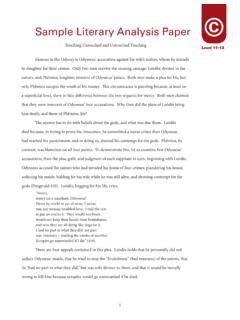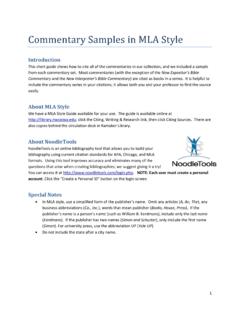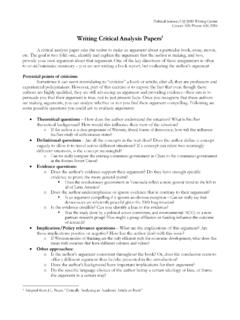Transcription of Sample Literary Analysis Paper - Tapestry of Grace
1 The Color of a Thread Everyone knows that Homer wrote great themes into his Odyssey, but his genius was not only in them. The Odyssey is trimmed with details so fine that readers at first do not recognize a pattern in the tracery of word on golden word. Yet such subtle patterns do exist, and tell us something both of Homer s Literary skill and of the impressions he intends to leave with us. This is clear even in the detail of wool colors on a woman s distaff, for Homer sometimes displays his skill by marking a lady s identifying characteristic through the color of the thread she spins. A succinct examination of Helen and Arete, two queens, will serve to illustrate this point. When we first meet her, Helen of Troy is in Menel os palace, welcoming Tel makhos. The servants bring sewing for her to do, a common occupation of ladies in the Odyssey.
2 Homer then begins to weave his delicate web, for he speaks of the distaff swathed in dusky violet wool (Fitzgerald 57). Now, at first glance this detail is a poetic nothing. Perhaps all royal ladies spun purple cloth. Purple was, after all, the color of kings. Yet if queens spin purple because it is royal, why do we find Arete, Queen of Phai kia, spinning a wool dyed richly as the sea (Fitzgerald 08), while she entertains Odysseus in her hall? Both women are queens. Why, therefore, does one spin with purple and the other with blue? The answer to this puzzle is embedded in symbolism. Arete and Helen are minor characters, and as such Homer will not spend long developing them, nor revisit their palaces. He gives us a symbol for each, an identifying characteristic to remember them by, and then sweep us away to another scene.
3 This need is answered brilliantly by the colors of the thread that Helen and Arete spin. Helen s wool is purple, the color of Aphrodite and of beauty. In her we have the world s most beautiful creature, the face that launched a thousand ships. Helen is incarnated beauty, in a sense, and therefore it is apt that her thread should be dyed to match. Purple thread symbolizes her identifying characteristic, beauty, and displays Homer s skill in making us remember the fact. Arete, likewise a queen, we find spinning a different skein. Why? It is because Arete is the great-granddaughter of Poseidon, the sea god. She also married her uncle, Alk no s, who was himself grandson to the same god through Naus tho s, Poseidon s son by Periboia. Thus Arete belonged to Level 8 This was not written by an 8th Grader; the language is therefore more elevated than we would expect from a student at this level, but see if you can learn from it!
4 The length and treatment of topic are correct for a Paper at this Literary Analysis Paper the lineage of the sea, by birth and by marriage, and that is why she spun yarn of a different color than Helen s (Fitzgerald - 3). Homer wants to illustrate to us her identifying characteristic; connection with the sea. This conclusion is supported in Book XIII, where Homer tells us that, the weaving nymphs make tissues, richly dyed as the deep sea is (Fitzgerald 3 ). Why does he use almost that same phrase, richly dyed as the sea, when speaking of nymphs? Is Homer merely providing a mnemonic (memorization) device for the itinerate poet, who must struggle to recite so many hundreds of lines from memory? The mnemonic explanation is not a bad one, but if that were the case, there was no need to give Helen another color.
5 Why not let all females spin sea-colored yarn? These nymphs, whose identities were also lapped in the fish-cold sea, spin the same hue as Arete. This fact lends credence to the conclusion that Homer s details of wool color went to satisfy a need for symbolism, for here we have sea-blue yarn spun in the Odyssey only by ladies directly connected to the sea. There are many grand topics to be examined in the Odyssey, and many great characters. Yet the Odyssey could not be so excellent a likeness of God s creativity if it did not include somewhere in its majestic lines small, intricate arrangements which serve to display the skill of the author, and impress with delicate pricks a few important symbols on our minds. In his use of so simple a thing as the color of wool on a distaff, Homer has accomplished this feat. By doing so, he has in some measure mirrored the CitedHomer, translated by Fitzgerald, Robert.
6 The Odyssey. New York: Farrar, Straus and Giroux, 998.











